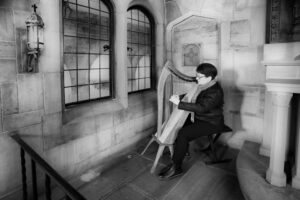Hi, I’m Cynthia Shelhart. You can call me Cindy. And it’s time for some #DoubleTalk. Double-strung harp, that is!
Welcome, or welcome back, to our channel featuring the modern double-strung harp and its music. We’ve just finished up a series of double-strung harp FAQ videos, featuring everything from “What is a double-strung harp?” and its historical roots, to choosing an instrument for yourself and getting started playing a double harp. If you missed those episodes—hey, it’s never too late for some Double Talk! Make sure to catch those episodes to catch up. And make sure you’re subscribed for future episodes.
About Know The Score
You’re here at just the right time for some exciting stuff. Starting with this episode, we’re switching gears for a new season. We’ll dig deeper into arranging music for double-strung harp with a new series called Know The Score.
Know The Score, which is new to Series 2, is a behind-the-scenes look at arranging for double-strung harp, based on The Shelhart Method™️, my approach to tunes, technique, and theory for double-strung harp.
Each episode also goes deeper on The Technique Triangle™️, my signature framework for double-strung harp technique, as part of The Shelhart Method.
This new series is going to focus on using The Technique Triangle in different ways with different arrangements, to really help your double-strung harp “sound more like a double.” You’ll see this in action with arrangements from my Double Dozen Series books: Double the Weddings, and Double the O’Carolan Tunes.
About The Technique Triangle
You might recognize these double-strung harp techniques from my method book, Make Mine a Double; they’re now known as The Technique Triangle, as part of The Shelhart Method. (I also wrote a blog post recently introducing The Technique Triangle, and I’ll put a link to that post in the show notes.) If you’re new to these techniques, or if you’d like a little reminder, we’ll take a look under the hood.
Each technique of The Technique Triangle is named for its main job in playing and creating double-strung harp music.
- You can use these techniques to create an unlimited number of double-strung harp patterns, but they’re still based on 1 or more of these 3 double-strung harp techniques. And the same pattern can be used in a variety of ways.
- Also, you don’t need to use all three of these techniques in the same arrangement. Using even just ONE of these techniques can help your double-strung harp “sound more like a double.”
The 3 Techniques
So let’s take a look at the 3 techniques:
Echo Technique
Echo Technique is the foundation sound of the double-strung harp—what everyone expects to hear from 2 rows of strings. This melodic technique features the 2 string rows, and they’re tuned in unison. And both hands echo the same notes back and forth.
Split Technique
Split Technique serves as the double-strung harp’s problem solver. It’s also a melodic technique. And it helps out, when you have repeated notes or an extended scale pattern, when you can split similar notes back and forth between hands, so that it’s easier to play. And Split Technique also includes some elements of Echo Technique.
Overlap Technique
The third technique, Overlap Technique, is what I like to call the “combo platter” of double-strung harp techniques. It weaves independent parts together, as both hands overlap in the same range to play two or more different parts at the same time, including accidentals. So that’s where some of the lever changes, or maybe not even having to make lever changes, can come in handy. In Overlap Technique, harmony and rhythm and texture share the same stage with the melodic techniques and elements from Echo and Split Techniques.
Wrapping Up
So, these 3 parts of The Technique Triangle, the part of The Shelhart Method that really helps your harp “sound more like a double,” are the foundation for our new look behind the scenes at the arranging process. You’ll see how I used these techniques—and how you can, too—with example arrangements from my Double Dozen book series.
Thanks for joining me today for Episode Zero, the overview of our new series. If you liked what you heard today, please make sure you’re subscribed, so you can be notified of future episodes. And if you really want to be the first to get some more Double Talk, head on over to my website, CindyShelhart.com, and sign up for my mailing list.
So stay tuned (and subscribed) for next time—our first Series 2 episode features some great ways to arrange with Echo Technique, that unmistakable sound of the double-strung harp. Get ready to Know The Score… see you next time!
